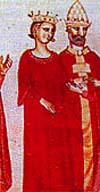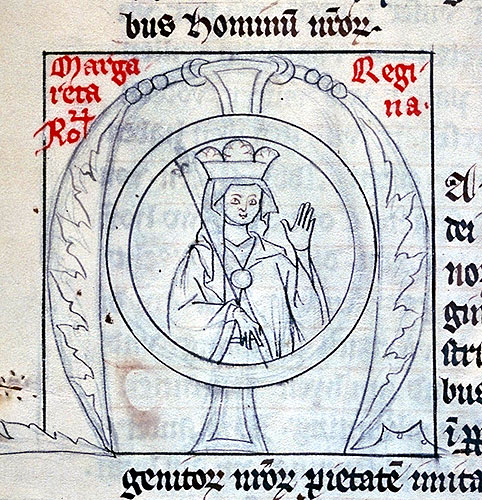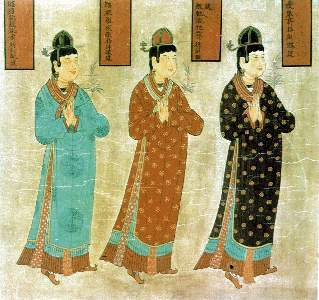|
1225
Year 1225 ( MCCXXV) was a common year starting on Wednesday (link will display the full calendar) of the Julian calendar. Events By place Mongol Empire * Autumn – Subutai is assigned a new campaign by Genghis Khan against the Tanguts. He crosses the Gobi Desert with a Mongol army and advances south into the Western Xia (or Xi Xia). Meanwhile, Genghis, in his mid-sixties, becomes wounded during hunting. His injury – a dislocated shoulder, perhaps, or a bruised rib – forces him to take some rest. * Iltutmish, Ghurid ruler of the Delhi Sultanate, repels a Mongol attack and invades Bengal. His rival, Ghiyasuddin, leads an army to halt Iltutmish's advance, but decides to avoid a conflict by paying him tribute and accepting his suzerainty. Europe * July 25 – Emperor Frederick II takes an oath at San Germano (near Cassino) and promises to depart on a Crusade (the Sixth Crusade), for the Near East in August 1227. He sends 1000 knights to the Levant and p ... [...More Info...] [...Related Items...] OR: [Wikipedia] [Google] [Baidu] |
Frederick II, Holy Roman Emperor
Frederick II (German language, German: ''Friedrich''; Italian language, Italian: ''Federico''; Latin: ''Federicus''; 26 December 1194 – 13 December 1250) was King of Sicily from 1198, King of Germany from 1212, King of Italy and Holy Roman Emperor from 1220 and King of Jerusalem from 1225. He was the son of emperor Henry VI, Holy Roman Emperor, Henry VI of the House of Hohenstaufen, Hohenstaufen dynasty and Queen Constance, Queen of Sicily, Constance of Sicily of the Hauteville family, Hauteville dynasty. His political and cultural ambitions were enormous as he ruled a vast area, beginning with Sicily and stretching through Italy all the way north to Germany. As the Crusades progressed, he acquired control of Jerusalem and styled himself its king. However, the Papacy became his enemy, and it eventually prevailed. Viewing himself as a direct successor to the Roman emperors of antiquity, he was Holy Roman Emperor, Emperor of the Romans from his papal coronation in 1220 until hi ... [...More Info...] [...Related Items...] OR: [Wikipedia] [Google] [Baidu] |
Sixth Crusade
The Sixth Crusade (1228–1229), also known as the Crusade of Frederick II, was a military expedition to recapture Jerusalem and the rest of the Holy Land. It began seven years after the failure of the Fifth Crusade and involved very little actual fighting. The diplomatic maneuvering of the Holy Roman Emperor and King of Sicily, Frederick II, resulted in the Kingdom of Jerusalem regaining some control over Jerusalem for much of the ensuing fifteen years as well as over other areas of the Holy Land. Western Europe after the Fifth Crusade The Fifth Crusade ended in 1221, having accomplished nothing. Despite numerous promises, Frederick II, Holy Roman Emperor, never joined the campaign, despite his vow to do so. The forces he sent to Egypt arrived too late to make a difference in the debacle, partially due to the lack of effective leadership. They would have to wait for many more years for Frederick's actions. When Pope Innocent III died in 1216, his successor Honorius III did n ... [...More Info...] [...Related Items...] OR: [Wikipedia] [Google] [Baidu] |
Isabella II Of Jerusalem
Isabella II (12124 May 1228), also known as Yolande of Brienne, was a princess of French origin, the daughter of Maria, the queen-regnant of Jerusalem, and her husband, John of Brienne. She was reigning Queen of Jerusalem from 1212 until her death in 1228. By marriage to Frederick II, Holy Roman Emperor, Isabella also became Holy Roman Empress and Queen of Sicily and Germany. Infant Queen Isabella II was born in Andria, in the southern Italian Kingdom of Sicily. She was the only child of Maria of Montferrat, Queen of Jerusalem, and John of Brienne. Maria was the daughter of Queen Isabella I of Jerusalem by her second husband Conrad I, and heiress, on her mother's death, of the Kingdom of Jerusalem. Maria died shortly after giving birth to Isabella II in 1212, possibly by puerperal fever. Because of this, Isabella II was proclaimed Queen of Jerusalem when she was only a few days old. Because her father John did not have a direct claim on the throne, he ruled as regent. Marria ... [...More Info...] [...Related Items...] OR: [Wikipedia] [Google] [Baidu] |
Margaret Of Austria, Queen Of Bohemia
Margaret of Austria (german: Margarethe von Österreich; – 29 October 1266), a member of the House of Babenberg, was German queen from 1225 until 1235, by her first marriage with King Henry (VII), and Queen of Bohemia from 1253 to 1260, by her second marriage with King Ottokar II. Biography Margaret was the eldest daughter of Duke Leopold VI of Austria (d. 1230) and his wife Theodora Angelina, a member of the Byzantine Imperial Angelus dynasty. Since 1198 Duke Leopold, according to the Georgenberg Pact, ruled over both the duchies of Austria and Styria. His court in Vienna became known as a centre of medieval Minnesang and he also played an important rule in the Empire's policies, acting as an arbitrator in the struggle between the Hohenstaufen emperor Frederick II and Pope Gregory IX. First marriage In the Imperial City of Nuremberg, on 29 November 1225, the 21-year-old Margaret was married to the 14-year-old Henry, eldest son of Emperor Frederick II and elected King o ... [...More Info...] [...Related Items...] OR: [Wikipedia] [Google] [Baidu] |
Western Xia
The Western Xia or the Xi Xia (), officially the Great Xia (), also known as the Tangut Empire, and known as ''Mi-nyak''Stein (1972), pp. 70–71. to the Tanguts and Tibetans, was a Tangut-led Buddhist imperial dynasty of China that existed from 1038 to 1227. At its peak, the dynasty ruled over the modern-day northwestern Chinese provinces of Ningxia, Gansu, eastern Qinghai, northern Shaanxi, northeastern Xinjiang, and southwest Inner Mongolia, and southernmost Outer Mongolia, measuring about . Its capital was Xingqing (modern Yinchuan), until its destruction by the Mongols in 1227. Most of its written records and architecture were destroyed, so the founders and history of the empire remained obscure until 20th-century research in China and the West. The Western Xia occupied the area around the Hexi Corridor, a stretch of the Silk Road, the most important trade route between northern China and Central Asia. They made significant achievements in literature, art, ... [...More Info...] [...Related Items...] OR: [Wikipedia] [Google] [Baidu] |
Henry (VII) Of Germany
Henry (VII) (1211 – 12? February 1242), a member of the Hohenstaufen dynasty, was King of Sicily from 1212 until 1217 and King of Germany (formally '' Rex Romanorum'') from 1220 until 1235, as son and co-ruler of Emperor Frederick II. He was the seventh Henry to rule Germany, but in order to avoid confusion with the Luxembourg emperor Henry VII, he is usually numbered Henry (VII). Under custody Henry was born in Sicily, the only son of King Frederick II and his first wife, Constance of Aragon.Steven Runciman, ''The Sicilian Vespers'', (Cambridge University Press, 2000), 26. He was the elder brother of Conrad IV, who eventually succeeded him as king. While Frederick sought to be elected German king against his Welf rival Otto IV, he had his new-born son crowned King of Sicily (as Henry II) by Pope Innocent III in March 1212, since an agreement between Frederick and the Pope stated that the kingdoms of Germany and Sicily should not be united under one ruler. For this, the regen ... [...More Info...] [...Related Items...] OR: [Wikipedia] [Google] [Baidu] |
Iltutmish
Shams ud-Din Iltutmish ( fa, شمس الدین ایلتتمش; died 30 April 1236, ) was the third of the Mamluk kings who ruled the former Ghurid territories in northern India. He was the first Muslim sovereign to rule from Delhi, and is thus considered the effective founder of the Delhi Sultanate. Sold into slavery as a young boy, Iltutmish spent his early life in Bukhara and Ghazni under multiple masters. In the late 1190s, the Ghurid slave-commander Qutb ud-Din Aibak purchased him in Delhi, thus making him the slave of a slave. Iltutmish rose to prominence in Aibak's service, and was granted the important iqta' of Badaun. His military actions against the Khokhar rebels in 1205–1206 gained attention of the Ghurid Emperor Mu'izz ad-Din, who manumitted him even before his master Aibak was manumitted. After Mu'izz ad-Din's death in 1206, Aibak became a practically independent ruler of the Ghurid territories in India, with his headquarters at Lahore. After Aibak's death, Ilt ... [...More Info...] [...Related Items...] OR: [Wikipedia] [Google] [Baidu] |
Crusader States
The Crusader States, also known as Outremer, were four Catholic realms in the Middle East that lasted from 1098 to 1291. These feudal polities were created by the Latin Catholic leaders of the First Crusade through conquest and political intrigue. The four states were the County of Edessa (10981150), the Principality of Antioch (10981287), the County of Tripoli (11021289), and the Kingdom of Jerusalem (10991291). The Kingdom of Jerusalem covered what is now Israel and Palestine, the West Bank, the Gaza Strip, and adjacent areas. The other northern states covered what are now Syria, south-eastern Turkey, and Lebanon. The description "Crusader states" can be misleading, as from 1130 very few of the Frankish population were crusaders. The term Outremer, used by medieval and modern writers as a synonym, is derived from the French for ''overseas''. In 1098, the armed pilgrimage to Jerusalem passed through Syria. The crusader Baldwin of Boulogne replaced the Greek Orthodox ruler ... [...More Info...] [...Related Items...] OR: [Wikipedia] [Google] [Baidu] |
Tangut People
The Tangut people ( Tangut: , ''mjɨ nja̱'' or , ''mji dzjwo''; ; ; mn, Тангуд) were a Tibeto-Burman tribal union that founded and inhabited the Western Xia dynasty. The group initially lived under Tuyuhun authority, but later submitted to the Tang dynasty, prior to their establishment of the Western Xia. They spoke the Tangut language, which was previously believed to be one of the Qiangic languages or Yi languages that belong to the Tibeto-Burman family. Phylogenetic and historical linguistic accounts, however, reveal that Tangut belonged to the Gyalrongic languages. Language The Tangut language, otherwise known as ''Fan'', belongs to the Tibeto-Burman branch of the Sino-Tibetan language family. Like many other Sino-Tibetan languages, it is a tonal language with predominantly mono-syllabic roots, but it shares certain grammatical traits central to the Tibeto-Burman branch. It is still debated as to whether Tangut belongs to the Yi or Qiangic subdivision of Tibeto-Burm ... [...More Info...] [...Related Items...] OR: [Wikipedia] [Google] [Baidu] |
Iwaz Khalji
Ḥusām ad-Dīn ʿIwaz bin Ḥusayn Khaljī ( bn, হুসামউদ্দীন ইওজ বিন হোসেন খলজী, fa, حسام الدین عوض بن حسین خلجی), later known by his regnal title as Ghiyāth ad-Dīn ʿIwaz Shāh ( bn, গিয়াসউদ্দীন ইওজ শাহ, fa, غیاث الدین عوض شاه), was a two-time governor of Bengal under the Delhi Sultanate, and a member of the Khalji dynasty of Bengal. During his second term, lasting from 1212 to 1227, Khalji declared himself as an independent ruler of Bengal. His regime has been described as "constructive" as Khalji made major developments to Bengal by innovating flood defence systems and interlinking major cities by means of constructing South Asia's earliest-recorded embankments and extending the Grand Trunk Road. Khalji was also responsible for establishing Bengal's first naval force, the complete fortification of Lakhnauti (Gaur) and the founding of the fort-town ... [...More Info...] [...Related Items...] OR: [Wikipedia] [Google] [Baidu] |
Kingdom Of Jerusalem
The Kingdom of Jerusalem ( la, Regnum Hierosolymitanum; fro, Roiaume de Jherusalem), officially known as the Latin Kingdom of Jerusalem or the Frankish Kingdom of Palestine,Example (title of works): was a Crusader state that was established in the Levant immediately after the First Crusade. It lasted for almost two hundred years, from the accession of Godfrey of Bouillon in 1099 until the siege of Acre in 1291. Its history is divided into two periods with a brief interruption in its existence, beginning with its collapse after the siege of Jerusalem in 1187 and its restoration after the Third Crusade in 1192. The original Kingdom of Jerusalem lasted from 1099 to 1187 before being almost entirely overrun by the Ayyubid Sultanate under Saladin. Following the Third Crusade, it was re-established in Acre in 1192. The re-established state is commonly known as the "Second Kingdom of Jerusalem" or alternatively as the "Kingdom of Acre" after its new capital city. Acre remained t ... [...More Info...] [...Related Items...] OR: [Wikipedia] [Google] [Baidu] |
Genghis Khan
''Chinggis Khaan'' ͡ʃʰiŋɡɪs xaːŋbr />Mongol script: ''Chinggis Qa(gh)an/ Chinggis Khagan'' , birth_name = Temüjin , successor = Tolui (as regent)Ögedei Khan , spouse = , issue = , house = Borjigin , dynasty = Genghisid , regnal name = Genghis Khan () , temple name = Taizu () , posthumous name = Emperor Fatian Qiyun Shengwu () , father = Yesügei , mother = Hoelun , religion = Tengrism , birth_date = , birth_place = Khentii Mountains, Khamag Mongol , death_date = (aged 64–65) , death_place = Xingqing, Western Xia , burial_place = Unknown(presumptively Ikh Khorig, Burkhan Khaldun, Khentii Province) Genghis Khan (born Temüjin; ; xng, Temüjin, script=Latn; ., name=Temujin – August 25, 1227) was the founder and first Great Khan (Emperor) of the Mongol Empire, which became the largest contiguous empire in history after his death. He came to power by uniting many of the nomadic tribes of t ... [...More Info...] [...Related Items...] OR: [Wikipedia] [Google] [Baidu] |




._Sind_type.jpg)



